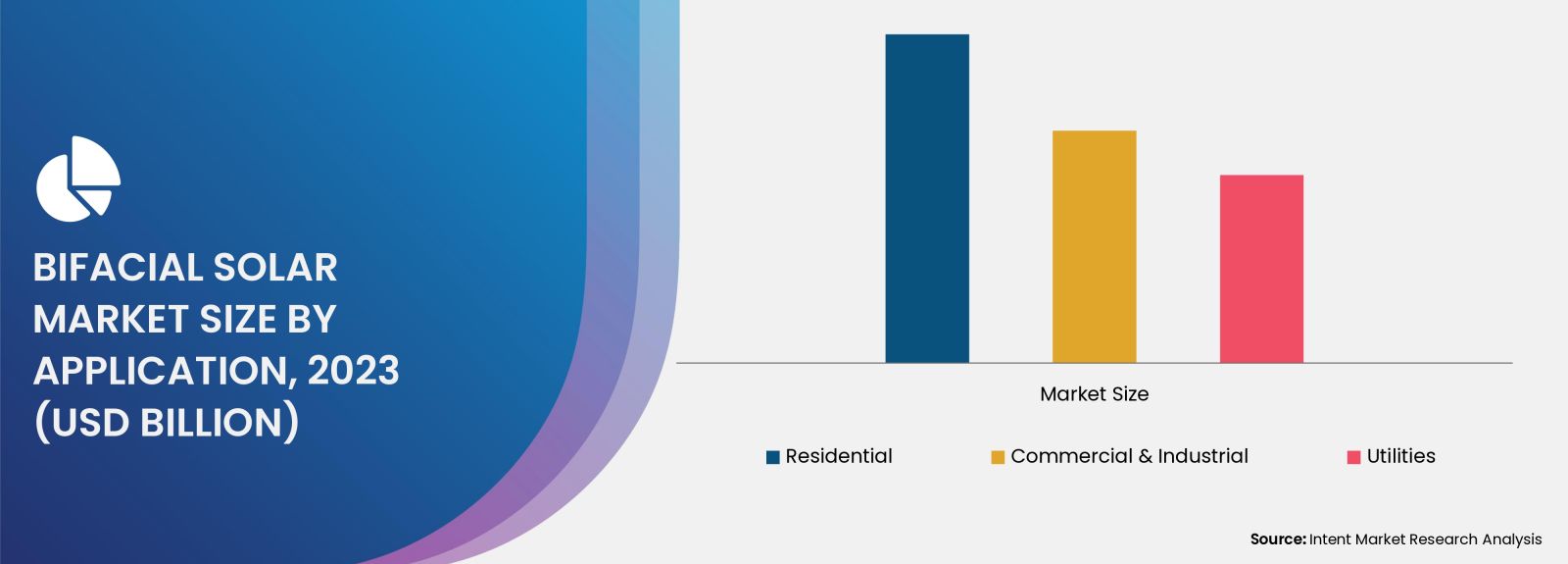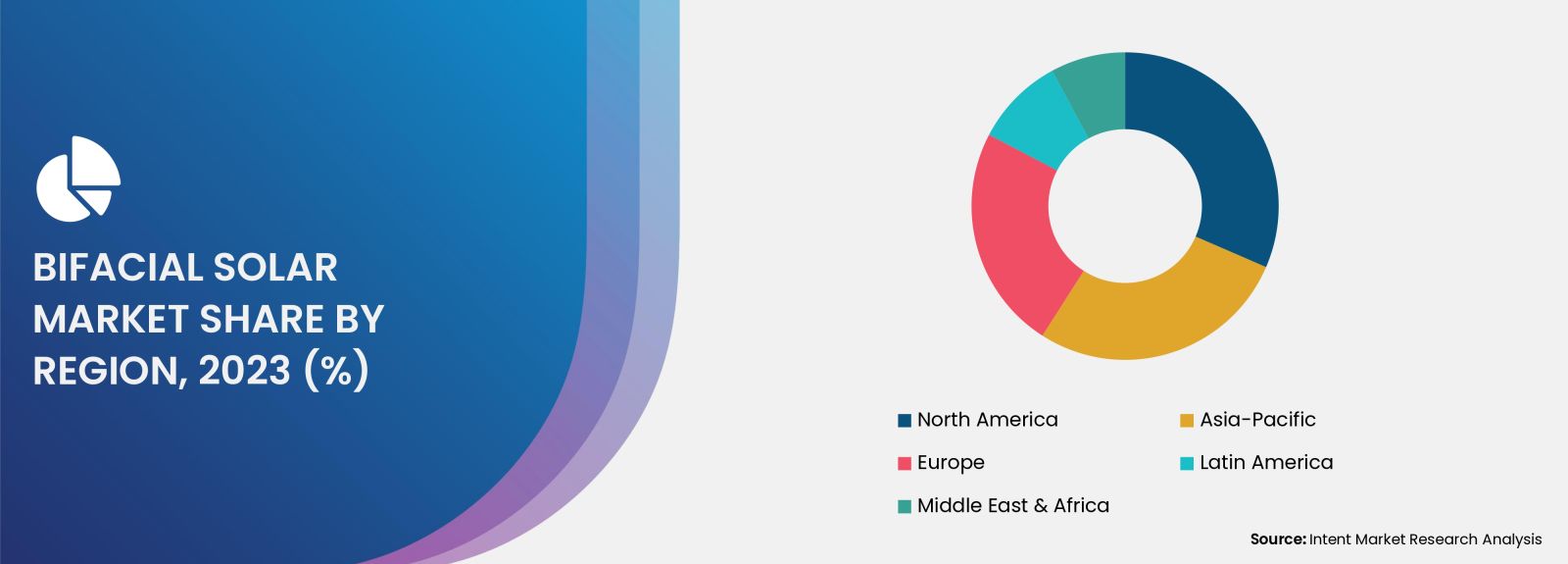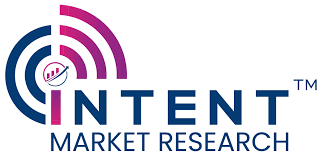As per Intent Market Research, the Bifacial Solar Market was valued at USD 18.1 billion in 2023 and will surpass USD 37.8 billion by 2030; growing at a CAGR of 11.1% during 2024 - 2030.

The residential segment to be the fastest growing market during the forecast period
Growing awareness of environmental challenges and the pressing need to address climate change are encouraging more homeowners to explore renewable energy options. With an increasing focus on reducing carbon footprints, there is a heightened emphasis on adopting sustainable practices. Bifacial solar panels, known for their superior efficiency and enhanced sunlight utilization, are becoming an appealing choice for residential energy requirements. Homeowners are driven by the dual advantages of supporting environmental conservation and achieving greater energy independence, resulting in a substantial increase in the demand for these advanced solar technologies.

Asia Pacific region to be the fastest-growing market for bifacial solar technology
Asia Pacific region to be the fastest-growing market during the forecast period. Various regional dynamics significantly influence the adoption of these technologies. Key factors include high solar irradiance levels, diverse climatic conditions, and different stages of economic development. The abundant sunlight in many areas creates optimal conditions for bifacial solar panels to enhance energy production.
Additionally, the region's varied climates, which range from tropical to temperate, necessitate durable and adaptable solar solutions, characteristics that bifacial panels offer. Economic growth across Asia Pacific, with many countries undergoing rapid industrialization and urbanization, further fuels the demand for advanced renewable energy solutions. Collectively, these regional factors shape the market landscape, positioning bifacial solar technologies as a promising energy solution for the Asia Pacific region.

The report focuses on estimating the current market potential in terms of the total addressable market for all the segments, sub-segments, and regions. In the process, all the high-growth and upcoming technologies were identified and analyzed to measure their impact on the current and future market. The report also identifies the key stakeholders, their business gaps, and their purchasing behavior. This information is essential for developing effective marketing strategies and creating products or services that meet the needs of the target market. The report also covers a detailed analysis of the competitive landscape which includes major players, their recent developments, growth strategies, product benchmarking, and manufacturing operations among others. Also, brief insights on start-up ecosystem and emerging companies is also included as part of this report.
Report Objectives:
The report will help you answer some of the most critical questions in the Bifacial Solar Market. A few of them are as follows:
- What are the key drivers, restraints, opportunities, and challenges influencing the market growth?
- What are the prevailing technology trends in the Bifacial Solar Market?
- What is the size of the Bifacial Solar Market based on segments, sub-segments, and regions?
- What is the size of different market segments across key regions: North America, Europe, Asia-Pacific, Latin America, Middle East & Africa?
- What are the market opportunities for stakeholders after analyzing key market trends?
- Who are the leading market players and what are their market share and core competencies?
- What is the degree of competition in the market and what are the key growth strategies adopted by leading players?
- What is the competitive landscape of the market, including market share analysis, revenue analysis, and a ranking of key players?
Report Scope:
|
Report Features |
Description |
|
Market Size (2023) |
USD 18.1 billion |
|
Forecasted Value (2030) |
USD 37.8 billion |
|
CAGR (2024 – 2030) |
11.1% |
|
Base Year for Estimation |
2023 |
|
Historic Year |
2022 |
|
Forecast Period |
2024 – 2030 |
|
Report Coverage |
Market Forecast, Market Dynamics, Competitive Landscape, Recent Developments |
|
Segments Covered |
Bifacial Solar Market By Type (Dual-Glass Bifacial Solar, Glass-Backsheet Bifacial Solar), By Power Capacity (Upto 200 WP, 200−400 WP, Above 400 WP), By Panel Type (Monocrystalline, Polycrystalline), By Frame Type (Framed Bifacial Solar, Frameless Bifacial Solar), By Cell Technology (Passivated Emitter Rear Contact, Topcon, Heterojunction), and By Application (Residential, Commercial & Industrial, Utilities) |
|
Regional Analysis |
North America (US, Canada, Mexico), Europe (Germany, France, UK, Italy, Spain, and Rest of Europe), Asia-Pacific (China, Japan, South Korea, Australia, India, and Rest of Asia-Pacific), Latin America (Brazil, Argentina, and Rest of Latin America), Middle East & Africa (Saudi Arabia, UAE, Rest of Middle East & Africa) |
|
Customization Scope |
Customization for segments, region/country-level will be provided. Moreover, additional customization can be done based on the requirements |
|
1. Introduction |
|
1.1. Market Definition |
|
1.2. Scope of the Study |
|
1.3. Research Assumptions |
|
1.4. Study Limitations |
|
2. Research Methodology |
|
2.1. Research Approach |
|
2.1.1. Top-Down Method |
|
2.1.2. Bottom-Up Method |
|
2.1.3. Factor Impact Analysis |
|
2.2. Insights & Data Collection Process |
|
2.2.1. Secondary Research |
|
2.2.2. Primary Research |
|
2.3. Data Mining Process |
|
2.3.1. Data Analysis |
|
2.3.2. Data Validation and Revalidation |
|
2.3.3. Data Triangulation |
|
3.Executive Summary |
|
3.1. Major Markets & Segments |
|
3.2. Highest Growing Regions and Respective Countries |
|
3.3. Impact of Growth Drivers & Inhibitors |
|
3.4. Regulatory Overview by Country |
|
4. Bifacial Solar Market, by Type (Market Size & Forecast: USD Million, 2022 – 2030) |
|
4.1. Dual-Glass Bifacial Solar |
|
4.2. Glass-Backsheet Bifacial Solar |
|
5. Bifacial Solar Market, by Power Capacity (Market Size & Forecast: USD Million, 2022 – 2030) |
|
5.1. Upto 200 WP |
|
5.2. 200−400 WP |
|
5.3. Above 400 WP |
|
6. Bifacial Solar Market, by Panel Type (Market Size & Forecast: USD Million, 2022 – 2030) |
|
6.1. Monocrystalline |
|
6.2. Polycrystalline |
|
7. Bifacial Solar Market, by Frame Type (Market Size & Forecast: USD Million, 2022 – 2030) |
|
7.1. Framed Bifacial Solar |
|
7.2. Frameless Bifacial Solar |
|
8. Bifacial Solar Market, by Cell Technology (Market Size & Forecast: USD Million, 2022 – 2030) |
|
8.1. Passivated Emitter Rear Contact |
|
8.2. Topcon |
|
8.3. Heterojunction |
|
8.4. Others |
|
9. Bifacial Solar Market, by Application (Market Size & Forecast: USD Million, 2022 – 2030) |
|
9.1. Residential |
|
9.2. Commercial & Industrial |
|
9.3. Utilities |
|
10. Regional Analysis (Market Size & Forecast: USD Million, 2022 – 2030) |
|
10.1. Regional Overview |
|
10.2. North America |
|
10.2.1. Regional Trends & Growth Drivers |
|
10.2.2. Barriers & Challenges |
|
10.2.3. Opportunities |
|
10.2.4. Factor Impact Analysis |
|
10.2.5. Technology Trends |
|
10.2.6. North America Bifacial Solar Market, by Type |
|
10.2.7. North America Bifacial Solar Market, by Power Capacity |
|
10.2.8. North America Bifacial Solar Market, by Panel Type |
|
10.2.9. North America Bifacial Solar Market, by Frame Type |
|
10.2.10. North America Bifacial Solar Market, by Cell Technology |
|
10.2.11. North America Bifacial Solar Market, by Application |
|
10.2.12. By Country |
|
10.2.12.1. US |
|
10.2.12.1.1. US Bifacial Solar Market, by Type |
|
10.2.12.1.2. US Bifacial Solar Market, by Power Capacity |
|
10.2.12.1.3. US Bifacial Solar Market, by Panel Type |
|
10.2.12.1.4. US Bifacial Solar Market, by Frame Type |
|
10.2.12.1.5. US Bifacial Solar Market, by Cell Technology |
|
10.2.12.1.6. US Bifacial Solar Market, by Application |
|
10.2.12.2. Canada |
|
10.2.12.3. Mexico |
|
*Similar segmentation will be provided for each region and country |
|
10.3. Europe |
|
10.4. Asia-Pacific |
|
10.5. Latin America |
|
10.6. Middle East & Africa |
|
11. Competitive Landscape |
|
11.1. Overview of the Key Players |
|
11.2. Competitive Ecosystem |
|
11.2.1. Level of Fragmentation |
|
11.2.2. Market Consolidation |
|
11.2.3. Product Innovation |
|
11.3. Company Share Analysis |
|
11.4. Company Benchmarking Matrix |
|
11.4.1. Strategic Overview |
|
11.4.2. Product Innovations |
|
11.5. Start-up Ecosystem |
|
11.6. Strategic Competitive Insights/ Customer Imperatives |
|
11.7. ESG Matrix/ Sustainability Matrix |
|
11.8. Manufacturing Network |
|
11.8.1. Locations |
|
11.8.2. Supply Chain and Logistics |
|
11.8.3. Product Flexibility/Customization |
|
11.8.4. Digital Transformation and Connectivity |
|
11.8.5. Environmental and Regulatory Compliance |
|
11.9. Technology Readiness Level Matrix |
|
11.10. Technology Maturity Curve |
|
11.11. Buying Criteria |
|
12. Company Profiles |
|
12.1. Adani Group |
|
12.1.1. Company Overview |
|
12.1.2. Company Financials |
|
12.1.3. Product/Service Portfolio |
|
12.1.4. Recent Developments |
|
12.1.5. IMR Analysis |
|
*Similar information will be provided for other companies |
|
12.2. Canadian Solar |
|
12.3. First Solar, Inc. |
|
12.4. JA SOLAR Technology Co., Ltd. |
|
12.5. Jinko Solar |
|
12.6. LONGi |
|
12.7. SHARP CORPORATION |
|
12.8. Tata Power Solar Systems Ltd. |
|
12.9. Trinasolar |
|
12.10. Wuxi Suntech Power Co., Ltd |
|
12.11. Yingli Solar |
|
13. Appendix |
A comprehensive market research approach was employed to gather and analyze data on the Bifacial Solar Market. In the process, the analysis was also done to analyze the parent market and relevant adjacencies to measure the impact of them on the Bifacial Solar Market. The research methodology encompassed both secondary and primary research techniques, ensuring the accuracy and credibility of the findings.
.jpg)
Secondary Research
Secondary research involved a thorough review of pertinent industry reports, journals, articles, and publications. Additionally, annual reports, press releases, and investor presentations of industry players were scrutinized to gain insights into their market positioning and strategies.
Primary Research
Primary research involved conducting in-depth interviews with industry experts, stakeholders, and market participants across the Bifacial Solar ecosystem. The primary research objectives included:
- Validating findings and assumptions derived from secondary research
- Gathering qualitative and quantitative data on market trends, drivers, and challenges
- Understanding the demand-side dynamics, encompassing end-users, component manufacturers, facility providers, and service providers
- Assessing the supply-side landscape, including technological advancements and recent developments
Market Size Assessment
A combination of top-down and bottom-up approaches was utilized to analyze the overall size of the Bifacial Solar Market. These methods were also employed to assess the size of various subsegments within the market. The market size assessment methodology encompassed the following steps:
- Identification of key industry players and relevant revenues through extensive secondary research
- Determination of the industry's supply chain and market size, in terms of value, through primary and secondary research processes
- Calculation of percentage shares, splits, and breakdowns using secondary sources and verification through primary sources
.jpg)
Data Triangulation
To ensure the accuracy and reliability of the market size, data triangulation was implemented. This involved cross-referencing data from various sources, including demand and supply side factors, market trends, and expert opinions. Additionally, top-down and bottom-up approaches were employed to validate the market size assessment.
NA
